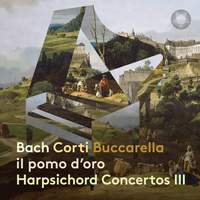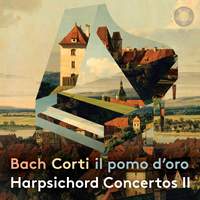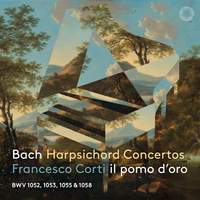Recording of the Week,
Adapted and reconstructed Bach concertos from Francesco Corti and Il Pomo d'Oro
For today’s Recording of the Week, Francesco Corti continues his journey through the harpsichord concertos of JS Bach with Il Pomo d’Oro. Like a mountaineer reaching dangerous altitudes, he’s now entered territory where it’s time to call on assistance of various kinds – musical partners for the double concertos, primarily fellow harpsichordist Andrea Buccarella, and scholarly collaborators for the reconstructed work that occupies pride of place on this album of adaptations and reworkings.
 BWV1062, with which the album opens, is Bach’s own arrangement of his double violin concerto – the soloists’ material is transferred fairly straightforwardly to the right hand of the harpsichord parts, with embellishments to the left hand parts fleshing things out into a busier texture. What the double harpsichord concerto loses in punch from the absence of the original’s vigorous downbows, it gains in the form of an endless rippling cascade of passagework (not short on pace, either) that allows both soloists to show off their effortless dexterity.
BWV1062, with which the album opens, is Bach’s own arrangement of his double violin concerto – the soloists’ material is transferred fairly straightforwardly to the right hand of the harpsichord parts, with embellishments to the left hand parts fleshing things out into a busier texture. What the double harpsichord concerto loses in punch from the absence of the original’s vigorous downbows, it gains in the form of an endless rippling cascade of passagework (not short on pace, either) that allows both soloists to show off their effortless dexterity.
The re-titling of the concerto’s central Largo as an Andante gives the authorial imprimatur to a significantly faster tempo, shaving almost a quarter off the movement’s usual duration – a pragmatic acceptance of the inability of harpsichords to produce the sustained melodic lines of the violin. One can almost imagine Bach smiling wryly when amending the first tempo marking. The harpsichord incarnation of this movement thus tends away from the sweeping and toward the lilting; after a moment to adjust, I found myself preferring it to the original. The link between Bach’s music and dance is much discussed and maybe even overstated at times, but the erstwhile Largo really does gain a stately sense of sarabande-like poise through being treated as a very slow one-in-a-bar. I try not to have “favourite” tracks on albums like this, but this hypnotic performance consistently drew me back.
 A tonal centre of C unifies much of the album – BWV1062 in C minor, the “true” double harpsichord concerto BWV1061 in C major, and the closing BWV1060 back in C minor. In keeping with the Baroque habit of freely repurposing music based on the available forces, not one of these works is quite what it seems. Even BWV1061 began life as a harpsichord duet without any orchestral component at all, and the two soloists’ performance somehow seems to capture that independence of spirit – merrily elbowing the orchestra aside with inexhaustibly extroverted playing and exciting flourishes.
A tonal centre of C unifies much of the album – BWV1062 in C minor, the “true” double harpsichord concerto BWV1061 in C major, and the closing BWV1060 back in C minor. In keeping with the Baroque habit of freely repurposing music based on the available forces, not one of these works is quite what it seems. Even BWV1061 began life as a harpsichord duet without any orchestral component at all, and the two soloists’ performance somehow seems to capture that independence of spirit – merrily elbowing the orchestra aside with inexhaustibly extroverted playing and exciting flourishes.
BWV1060, meanwhile, is thought to be our only surviving trace of a now-lost concerto for two melody instruments (sometimes performed today in a reconstruction for violin and oboe). The echo effect in the opening bars is accentuated by the distinctly lonely sound of single unaccompanied harpsichord notes, and it’s perhaps in response to this less ebullient character that Corti, Buccarella and Il Pomo d’Oro seem especially interested in creating flexible rubato moments. Where BWV1062’s opening movement was filled with thrilling forward motion, here everything is much more malleable.
 Bach’s own repurposing of his concertos is one thing, but reconstructions by others of his fragmentary works are another matter. The nine-bar incipit that constitutes BWV1059 has tantalised musicologists over the centuries – generating speculation as to why it was never completed, and various attempts to extend it into full-length works.
Bach’s own repurposing of his concertos is one thing, but reconstructions by others of his fragmentary works are another matter. The nine-bar incipit that constitutes BWV1059 has tantalised musicologists over the centuries – generating speculation as to why it was never completed, and various attempts to extend it into full-length works.
Perhaps inspired by Arnold Mehl’s 1983 approach (which reworked it as an oboe concerto), Corti here presents the fruits of his own reconstructive labours in collaboration with Francesco Zimei. As with Timothy Jones’s recent project to expand some of Mozart’s fragments, Corti and Zimei are more concerned with creating something original that is faithful to the spirit of the opening fragment, rather than trying to peer into the crystal ball and somehow discern what Bach “would have done”.
Those interested in the nuts and bolts of this fascinating undertaking can read more about the approach in the notes; my colleague Katherine has also been speaking to Corti about the series and his future plans, so watch out for that interview shortly! In brief, the reconstructing duo deduce from the fragment’s similarity to the cantata BWV35, and Bach’s self-borrowing habits elsewhere, that the entire concerto would have been, or should be, derived from that cantata. The oboe (Emmanuel Laporte, heroically flying the woodwind flag on an otherwise all-string album) enjoys a position of unusual prominence throughout – even designated a secondary concertante instrument alongside the harpsichord.
The interweaving of the two solo parts, both in composition and in performance, is wholly seamless and natural, as is the whole concerto. Close examination of the score might perhaps reveal tell-tale elements that betray the centuries separating Bach from Corti and Zimei – but taken in the spirit it is intended it’s simply a beautiful post-script to the Baroque. For what it’s worth, I was certainly taken in; the “Bach double concerto for oboe and harpsichord” may not be strictly authentic, but I can see no reason for audiences not to fall in love with it.
Francesco Corti (harpsichord), Andrea Buccarella (harpsichord), Il Pomo d'Oro
Available Formats: CD, MP3, FLAC, Hi-Res FLAC
Francesco Corti (harpsichord), Il Pomo d'Oro
Available Formats: CD, MP3, FLAC, Hi-Res FLAC, Hi-Res+ FLAC
Francesco Corti (harpsichord), Il Pomo d'Oro
Available Formats: CD, MP3, FLAC, Hi-Res FLAC





